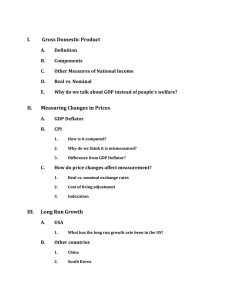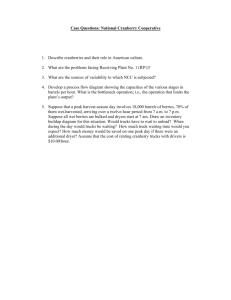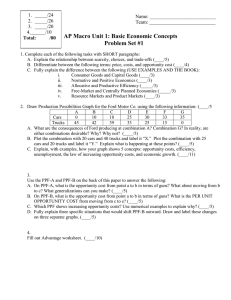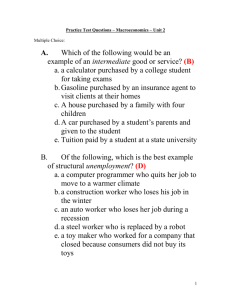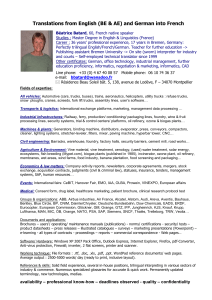Chain-Weighted GDP Worked Example (corrected version of pg. 35
advertisement
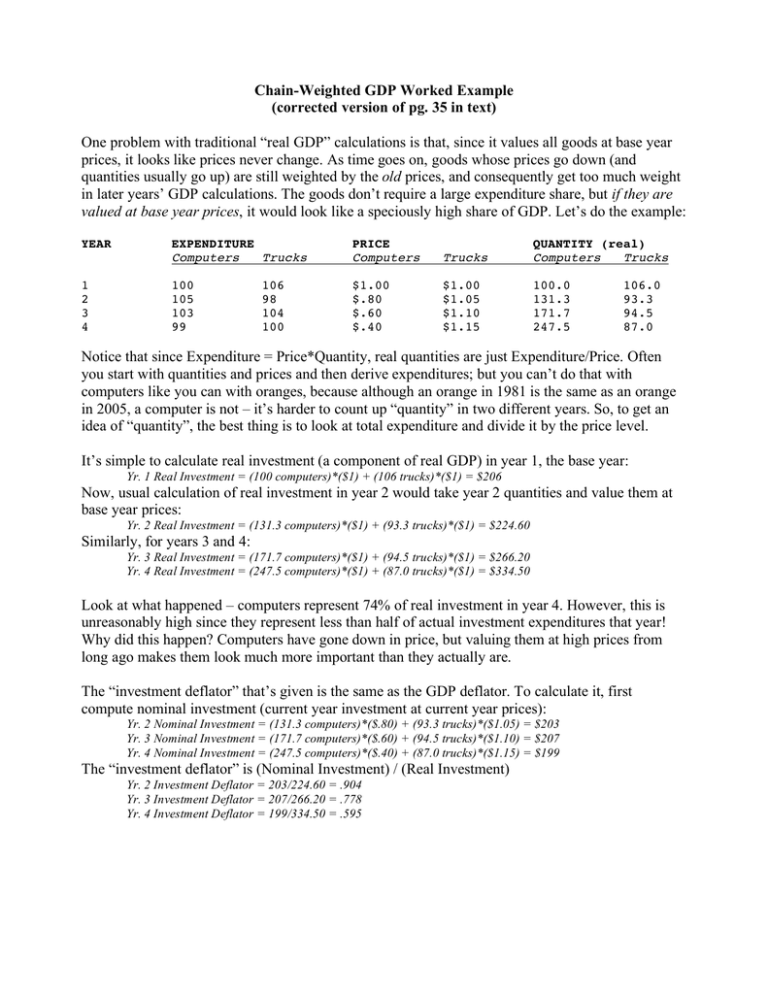
Chain-Weighted GDP Worked Example (corrected version of pg. 35 in text) One problem with traditional “real GDP” calculations is that, since it values all goods at base year prices, it looks like prices never change. As time goes on, goods whose prices go down (and quantities usually go up) are still weighted by the old prices, and consequently get too much weight in later years’ GDP calculations. The goods don’t require a large expenditure share, but if they are valued at base year prices, it would look like a speciously high share of GDP. Let’s do the example: YEAR 1 2 3 4 EXPENDITURE Computers Trucks PRICE Computers Trucks QUANTITY (real) Computers Trucks 100 105 103 99 $1.00 $.80 $.60 $.40 $1.00 $1.05 $1.10 $1.15 100.0 131.3 171.7 247.5 106 98 104 100 106.0 93.3 94.5 87.0 Notice that since Expenditure = Price*Quantity, real quantities are just Expenditure/Price. Often you start with quantities and prices and then derive expenditures; but you can’t do that with computers like you can with oranges, because although an orange in 1981 is the same as an orange in 2005, a computer is not – it’s harder to count up “quantity” in two different years. So, to get an idea of “quantity”, the best thing is to look at total expenditure and divide it by the price level. It’s simple to calculate real investment (a component of real GDP) in year 1, the base year: Yr. 1 Real Investment = (100 computers)*($1) + (106 trucks)*($1) = $206 Now, usual calculation of real investment in year 2 would take year 2 quantities and value them at base year prices: Yr. 2 Real Investment = (131.3 computers)*($1) + (93.3 trucks)*($1) = $224.60 Similarly, for years 3 and 4: Yr. 3 Real Investment = (171.7 computers)*($1) + (94.5 trucks)*($1) = $266.20 Yr. 4 Real Investment = (247.5 computers)*($1) + (87.0 trucks)*($1) = $334.50 Look at what happened – computers represent 74% of real investment in year 4. However, this is unreasonably high since they represent less than half of actual investment expenditures that year! Why did this happen? Computers have gone down in price, but valuing them at high prices from long ago makes them look much more important than they actually are. The “investment deflator” that’s given is the same as the GDP deflator. To calculate it, first compute nominal investment (current year investment at current year prices): Yr. 2 Nominal Investment = (131.3 computers)*($.80) + (93.3 trucks)*($1.05) = $203 Yr. 3 Nominal Investment = (171.7 computers)*($.60) + (94.5 trucks)*($1.10) = $207 Yr. 4 Nominal Investment = (247.5 computers)*($.40) + (87.0 trucks)*($1.15) = $199 The “investment deflator” is (Nominal Investment) / (Real Investment) Yr. 2 Investment Deflator = 203/224.60 = .904 Yr. 3 Investment Deflator = 207/266.20 = .778 Yr. 4 Investment Deflator = 199/334.50 = .595 How can we solve this problem with real GDP? The solution that the government recently began implementing in its reporting of GDP numbers is chain-weighting. The idea is to first calculate year-on-year real rate of growth of each component separately. Then, use expenditure shares for the current year to weight each component and calculate an average rate of growth. Then, apply this average growth rate to the previous year’s real GDP and calculate real (cumulated) GDP in the new year. Let’s see how this works in year 2: We do a year-on-year comparison of real quantities in years 1 and 2 to calculate the growth rate of each component separately comp _ new comp _ old 131.3 100 Growth _ computers = = = .313 comp _ old 100 93.3 106 Growth _ trucks = = .120 106 Now, in year 2, total expenditures were $203. Computers represent proportion $105/$203 = .517 of total expenditures, and trucks represent proportion $98/$203 = .483 of total expenditures. We use this to calculate an average growth rate, weighted by expenditure shares: avg. growth = (weight_computers)*(growth_computers) + (weight_trucks)*(growth_trucks) =(.517)*(.313) + (.483)*(-.120) =.104 So, total cumulated investment is 10.4% higher than the previous year. Since investment in the first year is $206, then applying this growth rate, cumulated real investment in year 2 is: Yr. 2 Real Investment = $206*(1+.104) = $227.42 Yr. 2 Deflator = (Yr. 2 nominal) / (Yr. 2 real) = 203/227.42 = .893 To do this for year 3, follow the same steps and calculate the growth rate of real quantities for each component between year 2 and year 3: computers grew (171.7-131.3) / (131.3) = .307, or 30.7%, and real quantities of trucks grew 1.3%. In the same year, computers were 49.8% of expenditures and trucks were 50.2% of expenditures. So, the average growth rate is: avg. growth = (.498)*(.307) + (.502)*(.013) = .159 We now add this growth rate to year 2’s real investment to get cumulated investment for year 3: Yr. 3 Real Investment = $227.42*(1+.159) = $263.58 Yr. 3 Deflator = (Yr. 3 nominal) / (Yr. 3 real) = 207/263.58 = .785 Here’s the complete corrected table. Make sure you can calculate the year 4 numbers yourself: YEAR WEIGHT FOR COMPUTERS 1 2 3 4 .485 .517 .498 .497 GROWTH RATE OF TOTAL REAL INVESTMENT CUMULATED TOTAL REAL INVESTMENT INVESTMENT DEFLATOR .104 .159 .179 $227.42 $263.58 $310.76 .893 .785 .640
